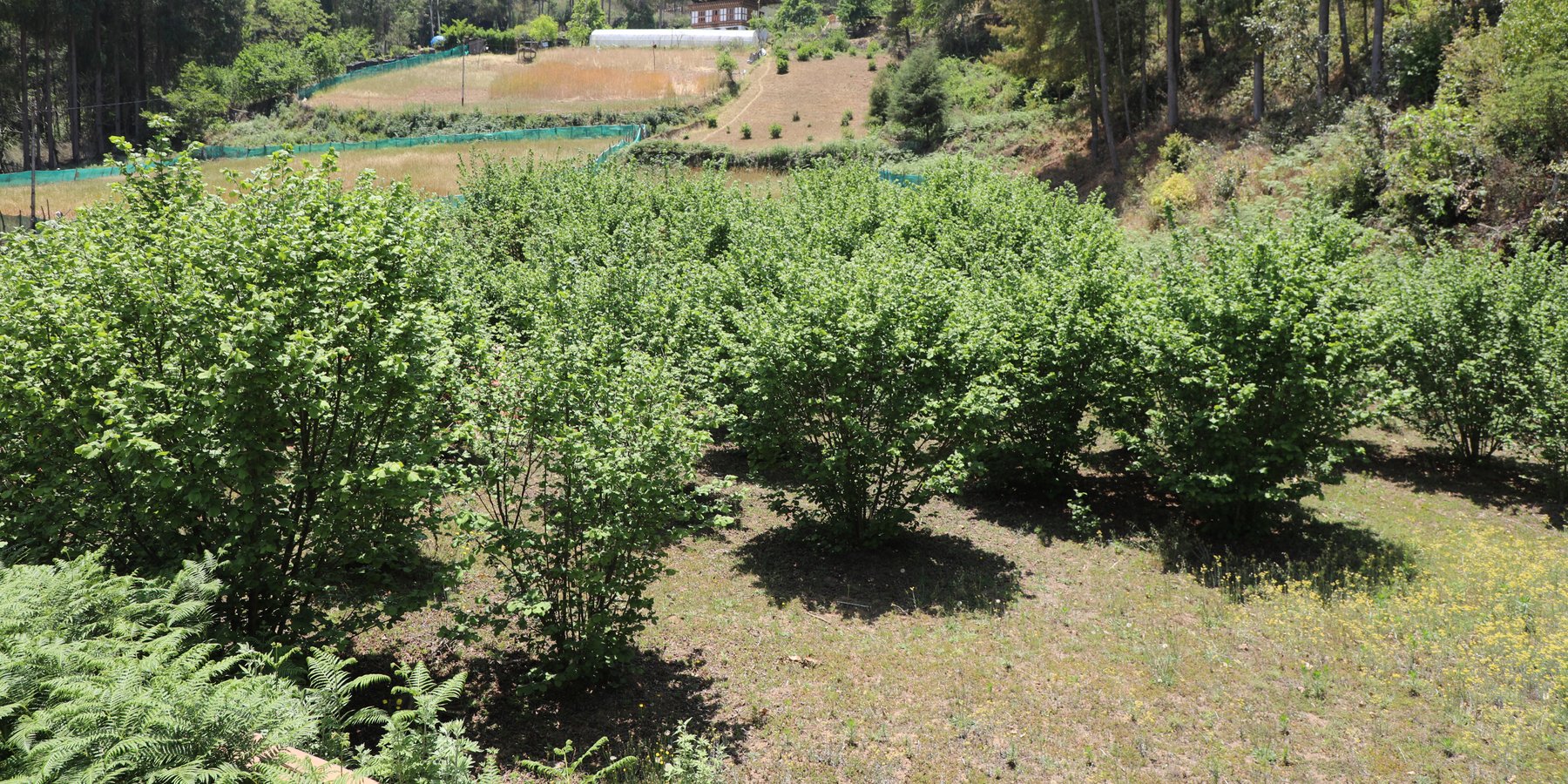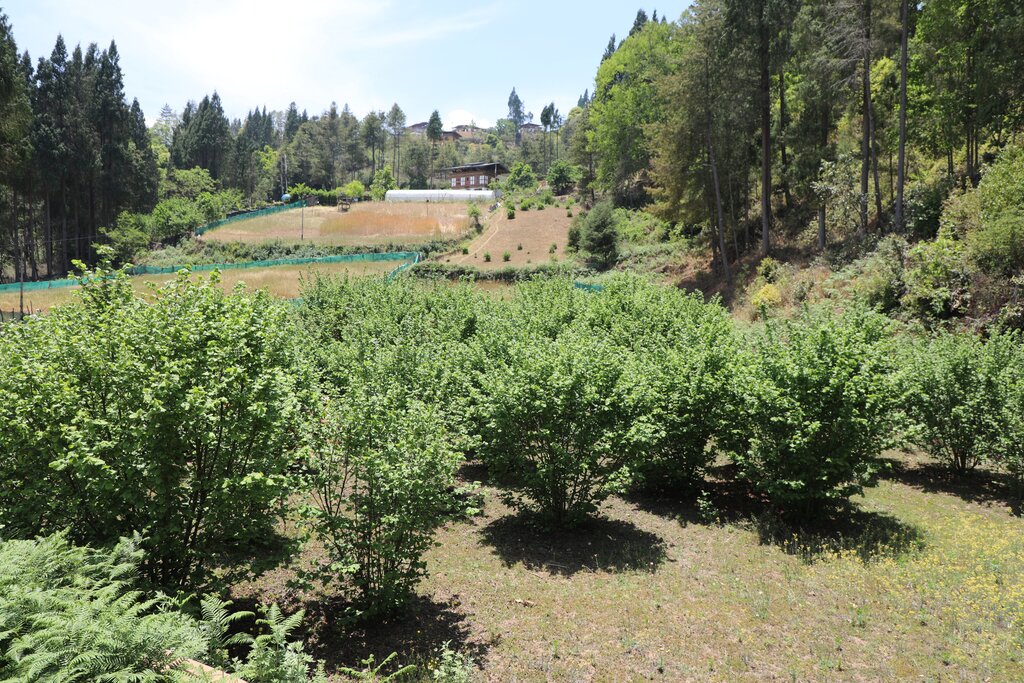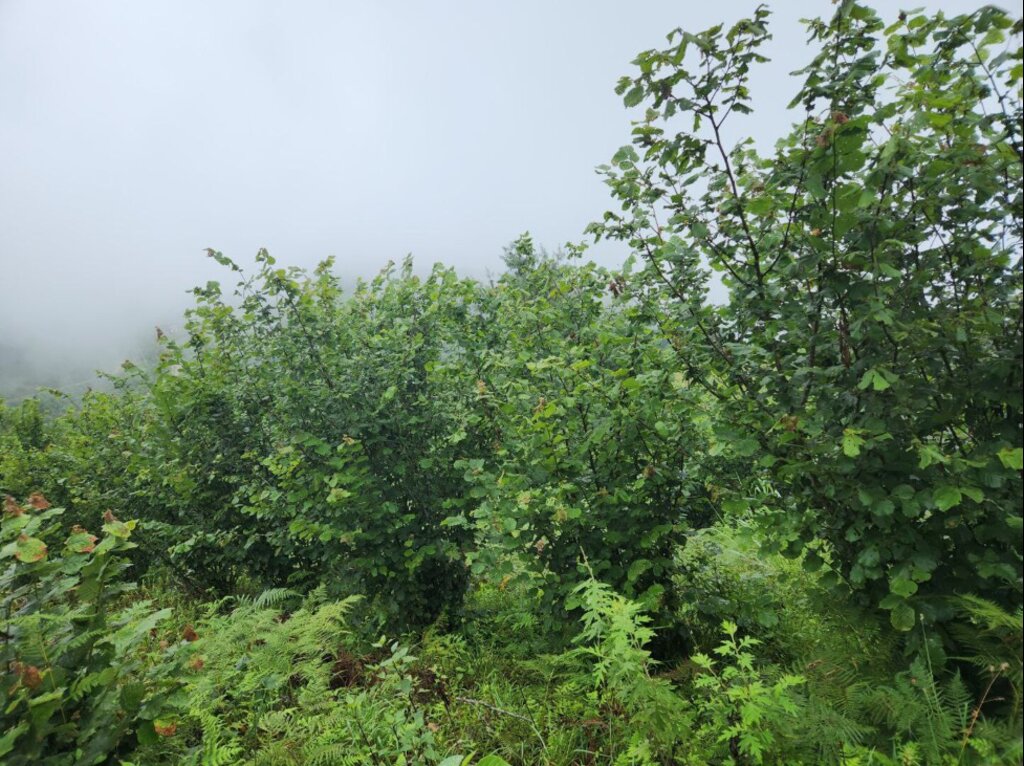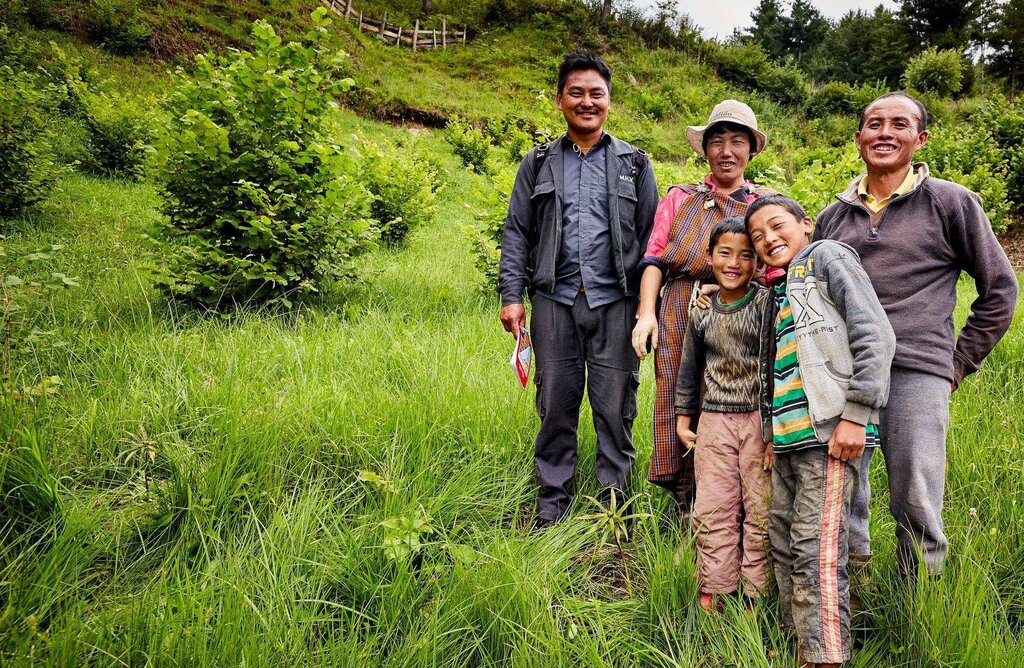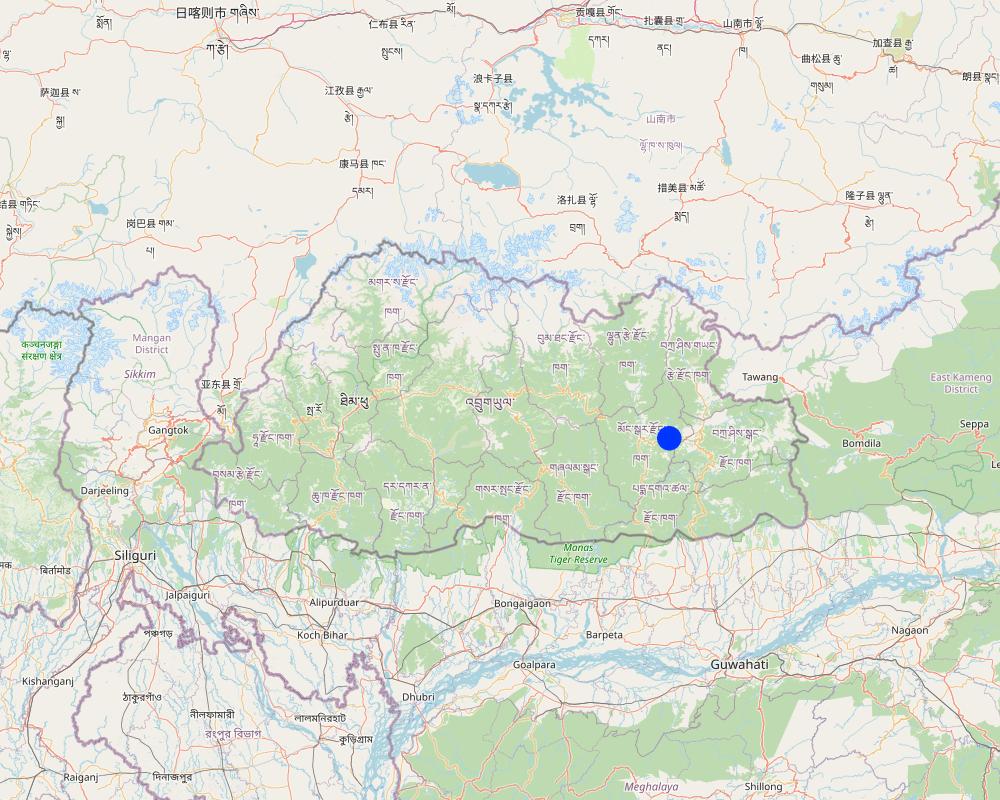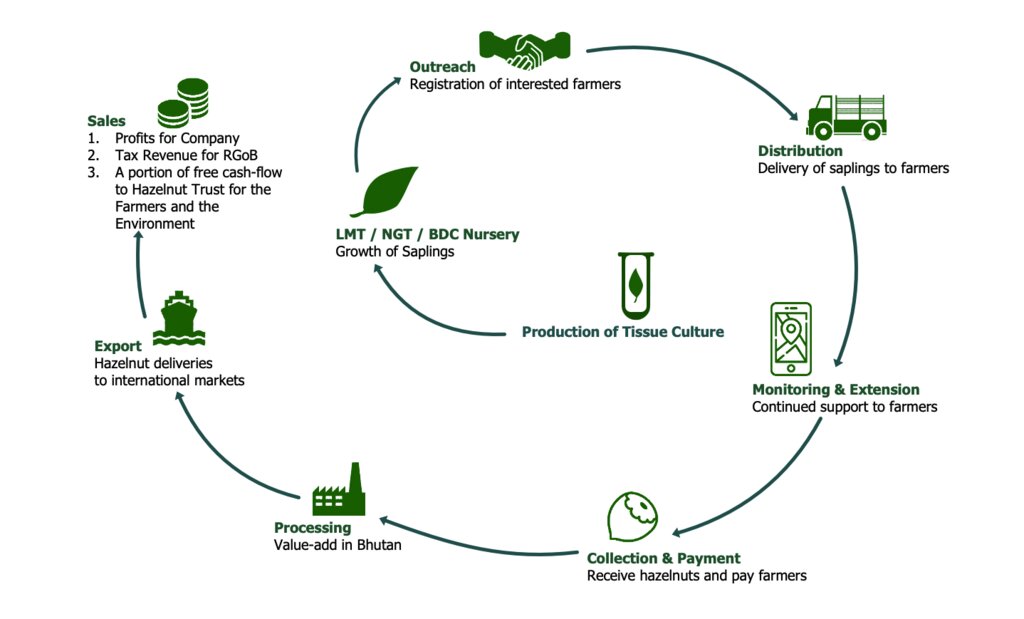Public-Private-Community Partnership for Land Degradation Neutrality [不丹]
- 创建:
- 更新:
- 编制者: ONGPO LEPCHA
- 编辑者: Kuenzang Nima
- 审查者: William Critchley, Rima Mekdaschi Studer
གཞུང་སྒེར་དམང་གསུམ་མཐུན་འགྲེལ་ཐོག་ས་ཆ་མར་ཉམས་བཀག་འཛིན།
approaches_6843 - 不丹
查看章节
全部展开 全部收起1. 一般信息
1.2 参与方法评估和文件编制的资源人员和机构的联系方式
关键资源人员
土地使用者:
Tenzin Karma
+975 77675442
Domlung village
Domlung village, Ngatshang gewog (block), Mongar Dzongkhag (district), Bhutan
不丹
土地使用者:
Penjor Tshewang
+97517544223
Domlung village
Domlung village, Ngatshang gewog (block), Mongar Dzongkhag (district), Bhutan
不丹
土地使用者:
Wangmo Yeshey
+97517680522
Domlung village
Domlung village, Ngatshang gewog (block), Mongar Dzongkhag (district), Bhutan
不丹
土地使用者:
Lhamo Ngawang
Domlung village
Domlung village, Ngatshang gewog (block), Mongar Dzongkhag (district), Bhutan
不丹
1.3 关于使用通过WOCAT记录的数据的条件
(现场)数据是什么时候汇编的?:
13/07/2023
编制者和关键资源人员接受有关使用通过WOCAT记录数据的条件。:
是
2. SLM方法的描述
2.1 该方法的简要说明
The public-private-community partnerships (PPCP) approach is a synergistically operational model that is used to achieve sustainable development in which the three parties jointly develop a business unit/service of mutual benefit and provide maximum benefit to the wider community. This approach is designed to enable economically disabled households and community organizations to generate long-term benefits through sustainable agriculture - in this case hazelnut production.
2.2 该方法的详细说明
该方法的详细说明:
The Mountain Hazelnut Venture (MHV) is a social enterprise established as a Public-Private-Community Partnership (PPCP) between the people and the Royal Government of Bhutan and a private company. The PPCP approach involves private entity funding of a project, and it has become common countrywide, The MHV has enabled a large-scale Foreign Direct Investment (FDI) project. The MHV provides hazelnut trees, agricultural inputs, and technical assistance to smallholder farmers. At harvest, the company purchases hazelnuts from partner growers, which are then processed for international export. The primary objective of this approach is to foster collaboration between the private company and the community to generate long-term income and revitalize vulnerable communities through sustainable agriculture. Hazelnut orchards stabilize mountain slopes, reduce soil erosion, improve water retention, and help adapt to, and mitigate, climate change by improving ground cover, retaining soil moisture and sequestering carbon.
The private company looks for interested farmers who are then registered. The company propagates good quality hazelnut seedlings and distributes them. This is followed up by constant monitoring by technical staff until fruits are harvested and processed. The implementation stage includes planning, providing them with necessary agricultural inputs, and technical support through extension and monitoring. Once the fruits are harvested, payment is made to the farmers. Implementation involves the MHV engaging with community members alongside agricultural extension agents to present and convince them about the benefits of the project. Additionally, the MHV provides training, workshops, and ongoing support. They finance the project while also taking on the role of monitoring and evaluating its outcomes.
There are three key stakeholders involved in this approach. They are the community members (landowners), the Royal Government of Bhutan, and the Mountain Hazelnut company. It is reported that there are more than 8,000 smallholder land users registered with MHV from 19 of 20 districts in Bhutan. The roles of the land users are to grow hazelnuts through nurturing the seedlings, harvesting the nuts, and selling them to the Hazelnut company as per the mutual agreement. Land users are provided free seedlings, consistent technical and field support, and the guaranteed buyback of nuts by the company. They also received training and assistance. The second key stakeholder is the Royal Government, who provides clearance and facilitates the establishment of business in line with the national Foreign Direct Investment (FDI) Policy. In the field, agriculture extension agents represent the government by facilitating communication between the hazelnut company and the communities. Lastly, the MHV as a private company is committed to fostering the development of entrepreneurs in the agribusiness sector across Bhutan.
The advantages of the approach to the land users are the financial, technical and material support provided by the private company. The land users can also develop their skills and knowledge through training on hazelnut cultivation and good agricultural practices (GAP). Hazelnut is a new crop in the locality.
Finally, the company is committed to generating income and improving the livelihood of rural communities in Bhutan. However, despite the noble objectives, the company has failed to realize its intended target, and this is an increasing cause of concern. Furthermore, there are complaints that the harvests have been poor – or even zero in some cases. It is clear that there had been inadequate investigation into the viability of hazelnuts in Bhutan. While failing on the economic front so far, from the land degradation neutrality (LDN) point of view, the hazelnut plantations have improved ground cover immensely thereby generating environmental benefits through stabilization of vulnerable agricultural land, reduction in land degradation and carbon sequestration.
2.3 该方法的照片
2.5 采用该方法的国家/地区/地点
国家:
不丹
区域/州/省:
Mongar Dzongkhag
有关地点的进一步说明:
Domlung village, Ngatshang gewog
Map
×2.6 该方法的开始和终止日期
注明开始年份:
2011
注释:
The approach is currently in the monitoring and evaluation phase since the Hazelnut trees in Domlung village have not fruited even once as like most other orchards in the country.
2.7 方法的类型
- 基于项目/方案
2.8 该方法的主要目的/目标
The primary objective of this approach is to persuade the community to embrace the Mountain Hazelnut Venture and foster collaboration between the private company and the community to advance the project, generate long-term income, revitalise vulnerable communities through sustainable agriculture, stabilising mountain slopes, reducing erosion, improving water retention, and mitigating climate change by improving soil fertility and carbon sequestration.
2.9 推动或妨碍实施本办法所适用的技术的条件
社会/文化/宗教规范和价值观
- 启动
Because land users are from same ethnic group, they shared similar culture and traditional. There were no objection from other land users on implementing the technology.
财务资源和服务的可用性/可得性
- 启动
The project is fully funded by a private company, meaning the company provides all the planting materials and inputs with regard to it; very minimal cost goes into the project by the land users.
参与者的的协作/协调
- 启动
Officials from the private company often visit the community to monitor and evaluate the progress of the project, and has played a significant role in providing the community members with all the skills and knowledge with regard to hazelnut cultivation.
了解SLM,获得技术支持
- 启动
The land users were trained on good agricultural practices (GAP) for hazelnut cultivation and proper land management practices before implementing the project.
市场(购买投入,销售产品)和价格
- 阻碍
Despite the guaranteed buyback by the company, the land users could not harvets any hazelnuts as there is no fruiting yet.
工作量、人力资源可用性
- 启动
Hazelnuts are fairly easy to grow and not much care is required. Hence not much of labour is required.
3. 相关利益相关者的参与和角色
3.1 该方法涉及的利益相关者及其职责
- 当地土地使用者/当地社区
Domlung community members (land users)
The roles of the Interested land users are to grow hazelnut saplings on their land, nurture these seedlings, harvest the nuts, and sell them to the Hazelnut company.
- 私营部门
Mountain Hazelnut Venture
It is committed to fostering the development of entrepreneurs in the agribusiness sector across Bhutan. It provides farmers with seedlings, and agricultural inputs such as fertilizers and extension services, and also buys the nuts from the land users. Apart from this Mountain Hazelnuts is committed to fostering the development of entrepreneurs in the agribusiness sector across Bhutan.
- 国家政府(规划者、决策者)
Ministry of Agriculture and Livestock of the Royal Government of Bhutan
Provided clearance and facilitaed business establishment as per the Foreign Direct Investment (FDI) Policy.
- Extension agent
Ngatshang gewog (block) Agriculture Extension Agent
Facilitated communication between the private company and the communities.
3.2 当地土地使用者/当地社区参与该方法的不同阶段
| 当地土地使用者/当地社区的参与 | 指定参与人员并描述活动 | |
|---|---|---|
| 启动/动机 | 互动 | The land users were sensitized on the Mountain Hazelnut Venture, in particular the long term benefits of improving income and livelihoods. Mutual agreements were signed between the company and the land users. |
| 计划 | 被动 | The private company (MHV) decide on the timeline of the project and how to implement it. However, the community members and the extension agents are informed about the plan. |
| 实施 | 自我动员 | For the implementation, land users were equipped with all the skills and materials required for the projects success. They plant and cultivate the hazelnut in their fields on their own, with some assistance from the company's field coordinator. |
| 监测/评估 | 互动 | Officials from the company (MHV) visits the land users field together with the land users, where the hazelnuts were cultivated and checks the progress of the project. |
3.3 流程图(如可用)
具体说明:
The flow chart of the approach was adopted from Mountain Hazelnut Venture (MHV) website
作者:
Mountain Hazelnut Venture website (https://www.mountainhazelnuts.com/)
3.4 有关SLM技术选择的决策
是否就技术的选择做出了决定?:
- Private sector (MHV)
解释:
The decision to implement the project in Domlung was done by the private company (MHV) based on their findings and agreement by the community.
明确做出决策的依据:
- 对充分记录的SLM知识进行评估(基于证据的决策)
4. 技术支持、能力建设和知识管理
4.1 能力建设/培训
是否为土地使用者/其他利益相关者提供培训?:
是
明确受训人员:
- 土地使用者
培训形式:
- 农民对农民
- 示范区域
- 公开会议
涵盖的主题:
The subjects covered included the cultivation of hazelnuts, good agricultural practices, proper land and agronomic management of hazelnuts, grafting, weed control, and sustainable land management.
注释:
The capacity building was financed by the private company and was supervised by the agricultural extension agent.
4.2 咨询服务
土地使用者有权使用咨询服务吗?:
是
指明是否提供了咨询服务:
- 在土地使用者的土地上
- Private company
说明/注释:
Advisory services were provided by the field coordinator and other officials from the private company (MHV).
4.3 机构强化(组织发展)
是否通过这种方法建立或加强了机构?:
- 否
4.4 监测和评估
监测和评估是该方法的一部分吗?:
是
注释:
In accordance with the land users of Domlung, officials from the private company visits the village sporadically to check the progress of the project.
若是,该文件是否用于监测和评估?:
否
4.5 研究
研究是该方法的一部分吗?
否
5. 融资和外部物质支持
5.1 该方法中SLM组成部分的年度预算
说明该方法中SLM部分的年度预算,单位为美元:
30000000.00
注释(例如主要的资助来源/主要捐助者):
Mountain Hazelnut Venture (The annual budget is the total investment of the company for the entire project)
5.2 为土地使用者提供财政/物质支援
土地使用者是否获得实施该技术的财政/物质支持?:
是
如果是,请具体说明支持的类型、条件和提供者:
The financial support was received in the form of planting materials and other materials such as fencing.
5.3 对特定投入的补贴(包括劳动力)
- 设备
| 具体说明哪些投入得到了补贴 | 程度如何 | 对补贴做出具体说明 |
|---|---|---|
| Nets | 充分融资 | Green nets |
- 农业
| 具体说明哪些投入得到了补贴 | 程度如何 | 对补贴做出具体说明 |
|---|---|---|
| 种子 | 充分融资 | Hazelnut saplings were provided to the land users for free of cost. |
| 化肥 | 部分融资 | Fertilizers are bought at 50% of its original price by the land users. |
如果土地使用者的劳动力是一项重要的投入,那么是不是:
- 获得其他物质支持
5.4 信用
是否根据SLM活动的方法给予信用值?:
否
5.5 其它激励或手段
是否有其他激励措施或工具用于促进SLM技术的实施?:
否
6. 影响分析和结论性陈述
6.1 方法的影响
该方法是否帮助土地使用者实施和维护SLM技术?:
- 否
- 是,很少
- 是,中等
- 是,支持力度很大
Almost all the farming households in Domlung have cultivated hazelnuts. They were trained on how to manage land and they also reported the benefits of growing trees besides harvesting the nuts.
该方法是否调动/改善了使用财务资源实施SLM的途径?:
- 否
- 是,很少
- 是,中等
- 是,支持力度很大
There was no improvement in access to financial resources, but the land users have been supported financially for the project through provisin of inputs either free or on cost sharing basis.
该方法是否提高了土地使用者实施土地管理的知识和能力?:
- 否
- 是,很少
- 是,中等
- 是,支持力度很大
All the land users in Domlung village have attended several trainings and workshops before the project implementation. Some of this training included SLM intervention topics like Terrace making, stone bund walls, and growing hazelnuts in erosion-prone areas.
该方法是否建立/加强了机构、利益相关者之间的合作?:
- 否
- 是,很少
- 是,中等
- 是,支持力度很大
The approach involves three main stakeholders i.e., land users, extension officers of the Royal Government and the private company. The approach has strengthened collaboration between stakeholders, i.e., land users and extension, extension and private company, etc.
该方法是否有助于社会和经济弱势群体?:
- 否
- 是,很少
- 是,中等
- 是,支持力度很大
All the land users were engaged as stakeholders and were equally benefited.
该方法是否改善了性别平等并赋予女性权力?:
- 否
- 是,很少
- 是,中等
- 是,支持力度很大
The approach allowed both men and women to participate. Thus gender equality was well taken care. It is also one of the company's objectives to ensure that women comprise approximately half of MH staff at all levels, from community lead growers through the executive team.
该方法是否鼓励年轻人/下一代土地使用者参与SLM?:
- 否
- 是,很少
- 是,中等
- 是,支持力度很大
Young land users of the community were the ones who showed more interest to the project.
该方法是否改善了粮食安全/改善了营养?:
- 否
- 是,很少
- 是,中等
- 是,支持力度很大
Although the land was cleared for planting hazelnuts, there were problems with pollination and variety resulting no fruiting. As a result land users turned hopeless without any income.
该方法是否改善了市场准入?:
- 否
- 是,很少
- 是,中等
- 是,支持力度很大
Access to the market was assured through the project. However, there was no nut production.
该方法是否提高了土地使用者适应气候变化/极端情况和减轻气候相关灾害的能力?:
- 否
- 是,很少
- 是,中等
- 是,支持力度很大
Hazelnut plantation improved ground cover thereby enabling carbon sequestration and soil organic matter.
该方法是否会带来就业、收入机会?:
- 否
- 是,很少
- 是,中等
- 是,支持力度很大
Individuals from outside the community were able to work for the private company in the last few years.
Contribution ot Land Degradation Neutrality (LDN):
- 否
- 是,很少
- 是,中等
- 是,支持力度很大
Although the MHV project failed to fully realize its main economic objective of income generation, the hazelnut plantation did improve ground cover and helped avoid, reduce and restore degraded land. It thus contributed towards achieveing voluntary Land Degradation Target (LDN) target set by the Royal Government of Bhutan.
6.2 土地使用者实施SLM的主要动机
- 增加生产
The main motivation was to increase the production by growing hazelnut in marginal land. However, due to pollination and variety issues there was no production.
- 增加利润(能力),提高成本效益比
With assured market, the company's main objective was to enable sustainable source of income for farmer and increase profitability. Even during the implementation process most of the costs were borne by the project thus giving less financial burden to the land users.
- 减少土地退化
Although the land users did not see direct relation between hazelnut plantation and land degradation, after the training provided by the company, they did realize that the hazelnut plantation can help reduce land degradation through improved ground cover.
- 减少工作量
Hazelnuts are hardy plants (adaptable) and fairly easy to grow and manage as compared to other economic crops like vegetables and cereals. This gives some leisure time to the land users.
- 提高SLM知识和技能
Before Hazelnuts plantation, land remained barren and exposed to different factors of land degradation. However, with hazelnut plantation, the lands are covered from direct sun and rain thereby preventing land degradation. Many land users shared that they didn't have this idea/knowledge before.
6.3 方法活动的可持续性
土地使用者能否维持通过该方法实施的措施(无外部支持的情况下)?:
- 否
若否或不确定,请具体说明并予以注释:
The land users who agreed to grow hazelnuts were the ones who were economically disabled. They could have sustained what was implemented through the approach if everything had gone as planned. However, there has been almost zero production of the hazelnuts from almost all hazelnut growing areas which has seriously affected the income. It has been almost 12 years since the first implementation of the project. Land users mentioned that they are now looking for other alternatives so that they can uproot hazelnuts and replace them with some other productive crop.
6.4 该方法的长处/优点
| 土地使用者眼中的长处/优势/机会 |
|---|
| Support from the company: Easy for the land users to implement the project due to material and technical supports from the approach. Land users received inputs like hazelnut seedlings at the beginning, which was for free. They also received support for growing the seedlings, Taking care of the seedlings, etc., |
| Assured market: Land users also mentioned that the main motivation to get involved in such an approach was the market and the possibility of generating income. The company was willing to buy whatever quantity of hazelnuts they could produce from their land. |
| Capacity development: In addition to the support (agricultural inputs), the land users also received various training through which they were exposed to other technologies which some of them were totally unaware. They could enhance their skills and knowledge on hazelnut production like orchard cultivation, hazelnut value-chain, including processing and the provision of goods and services. |
| 编制者或其他关键资源人员认为的长处/优势/机会 |
|---|
| Opportunities to economically disabled land users: One of the primary objectives of Mountain Hazelnut Venture is to enable smallholder farming households to generate long-term income, revitalize vulnerable communities through sustainable agriculture. Through this approach many youths were given employment as a worker in the project sites. |
| Focus on sustainable land management: The approach made land uesres to grow hazelnuts sapling in their marginal or unproductive land. When hazelnuts is fully grown, hazelnut plantations stabilize mountain slopes, reduce soil erosion, improve water retention, and mitigate climate change by improving soil fertility and carbon sequestration. In brief, hazelnut plantation as a SLM intervention, contributes to the realization of the land degradation neutrality (LDN) target and adapt to and mitigate climate change. |
6.5 该方法的弱点/缺点以及克服它们的方法
| 土地使用者认为的弱点/缺点/风险 | 如何克服它们? |
|---|---|
| No transparency of the information: Land users shared that they were lured by some officals saying the approach to be very profitable. They didn't explained them very well on positive and negative long term impact of the project. They didnt know about the plant (hazelnuts), Its problem in fruiting, etc., | This type of project is maily implemented for the welfare of the community. It should never be implemented for sole benefit of the company. |
| 编制者或其他关键资源人员认为的弱点/缺点/风险 | 如何克服它们? |
|---|---|
| No proper planning and research: The main reason why this hazelnut planations failed in many places in Bhutan could be due to lack of proper planning and research. Given the wide range of elevation and climatic conditions in Bhutan, more adaptability or suitability trials at different elevations could have been conducted. | Suitability trials of different varieties of hazelnuts could have been done so that the best performing varieties and management practices could have been promoted to the land users on large scale. |
| No risk management: It appears like the MHV initiated its business with full confidnce that the project will do well in Bhutan and as such no risk management plans were in place. For instance, land users sacrificed most of their land with the hope of generating good income, but this didn't happen in reality. Many land users were left devasted and hopeless without any compensation from the company. | Any project should account the risk and accordingly provision risk management plan in the proposal and agreement. Such provisions should also be made transparent to all the parties so that it becomes very clear about the compensation should the project fail. |
7. 参考和链接
7.1 方法/信息来源
- 实地考察、实地调查
One household
- 与土地使用者的访谈
Four individuals
7.2 参考可用出版物
标题、作者、年份、ISBN:
Asian Development Bank. (n.d.). Public-Private Partnership Handbook. ADB.
可以从哪里获得?成本如何?
https://www.adb.org/sites/default/files/institutional-document/31484/public-private-partnership.pdf
标题、作者、年份、ISBN:
Perez, M. C. (2015). Public-Private-Community-Partnerships for Renewable Energy Cooperatives. Wegeningen UR.
可以从哪里获得?成本如何?
https://edepot.wur.nl/337095
7.3 链接到网络上可用的相关信息
标题/说明:
Mountain Hazelnut Venture
URL:
https://www.mountainhazelnuts.com/
标题/说明:
Public–Private–Community Partnership
URL:
https://penabulufoundation.org/en/public-private-community-partnership/
链接和模块
全部展开 全部收起链接
无链接
模块
无模块


